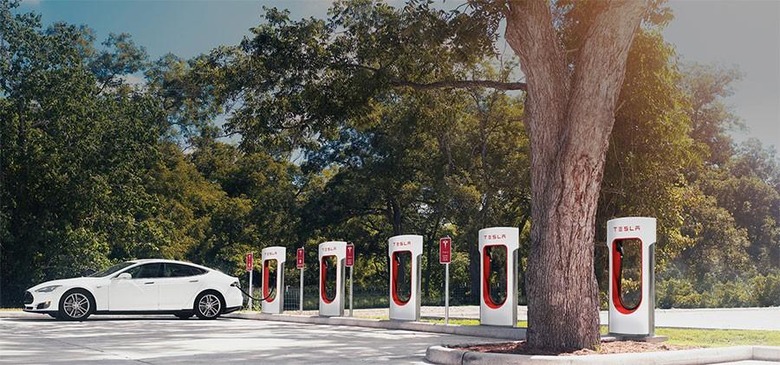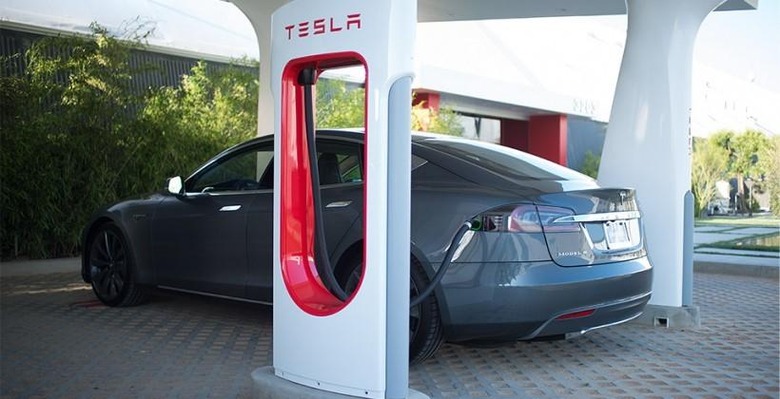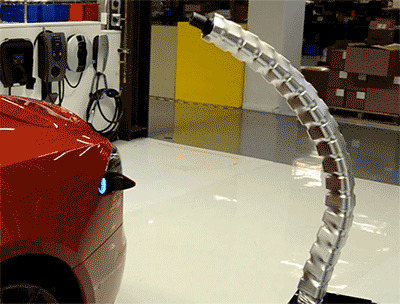Tesla's Model S Has A Huge Charging Problem
Offer people free power for their electric cars and they'll undoubtedly plug in and take you up on that offer, and that leaves Tesla in a potentially tough spot. One of the electric car maker's perks for drivers of its Model S and Model X EVs is access to the Supercharger network, a growing number of high-speed charging stations at which not only do the vehicles get juiced-up fast, it doesn't cost a thing.
That's because, aside from one discontinued option of charging cheaper Model S buyers a $2,000 upgrade to get Supercharger access, the cost of that perk is built into the not-inconsiderable sticker price of the cars themselves.
It's become one of the big selling points for Tesla cars over rival all-electric and plug-in hybrid models. While some automakers, including BMW and Nissan, have run schemes where select EVs get free charges on certain third-party networks, none have waded into infrastructure roll-out in the same way that Tesla has.
The new Tesla Model 3 could throw all of that into disarray.

Currently, the Supercharger network is designed for the sort of cars Tesla has offered until now. With their luxury vehicle pricing, neither the Model S nor the more recent Model X are intended for the mass-market: a few of the high-speed, free charging points in strategic locations has generally been sufficient to keep that fairly small number of drivers moving.
Even so, Supercharger congestion is increasingly becoming an issue. In fact, Tesla recently installed a decidedly low-tech solution to handling demand exceeding supply at some popular spots, employing what amount to Supercharger valets to switch cars between chargers while the owners are otherwise distracted.
That may be practical for now, but – even if the promise is up to 170 miles of range from 30 minutes plugged-in – it's not hard to see how quickly it'll become impractical when Model 3 arrives. Tesla's EV for the mass market is priced to sell, with a $35,000 sticker before federal and state subsidies, and even if options and upgrades add $10-20k on top of that, it's still potentially half what you'd pay for a Model S.
If the preorder lines snaking around Tesla dealerships already – with the car yet to be revealed, no less – are anything to go by, Elon Musk & Co. won't be short of takers. So, where are all those Model 3 cars going to recharge?

Supercharger access for the new car is something Tesla is yet to comment on, though there are really only a few possibilities. Most draconian – though most accommodating for existing Model S and X drivers – would be denying the Model 3 free Supercharger use completely, on the understanding that the cheaper car lacks the built-in subsidization implicit in its more expensive siblings.
Instead, Model 3 drivers could end up paying per-charge, billing their electricity use to an account tied into the car's connected dashboard. Practically, it'd be straightforward to do – Tesla's software already supports locating the nearest charging point and scheduling charges – though owners might feel under-valued.
Alternatively, unlimited Supercharger use could be offered as a cost-option. Tesla did that once before, on the discontinued 60 kWh Model S RWD; that, as standard, didn't get to use the network of chargers, but $2k changed that.
The question there is how much could Tesla reasonably charge, not turn off Model 3 owners in the process, and still afford to pay for the necessary expansion when thousands – ramping up to tens of thousands – of new EVs start demanding the same access to Superchargers as Model S and X drivers have enjoyed so far.
Finally, there's the golden ticket option: Supercharger use as standard with every Model 3. That would certainly make for plenty of goodwill for Tesla, but investors may not be so keen, especially given the billions the company is already spending on building its battery-producing Gigafactory.
Supercharging as an option seems the most practical solution: it's entirely possible that some Model 3 owners will be content with recharging their EV while at home and maybe at work, especially if the roughly 200 mile range promise holds true in the real-world. After all, the average US commute is less than half that distance each day.

Tesla being Tesla, however, it comes as no surprise that the pieces for a more technological fix to Supercharger congestion are already in the works. The company has already demonstrated how Auto Pilot can autonomously drive an electric car from the garage to your front door, as well as a robotic "snake" arm which could reach out and plug in at the charging port.
NOW READ: The big questions the Model 3 must answer
Picture, then, a Supercharger station which knows where your Tesla is parked, maintains a wait list of cars to be recharged, and can pilot it over and plug it in when your slot arrives – all without any human intervention. Not only has Tesla shown it would be eminently practical given its current technology, it would be just the sort of eye-catching EV theater that Elon Musk adores.
There's a way to go before we have anything like that, however. First, Tesla needs to break the news to the thousands of Model 3 preorder customers as to what, exactly, their affordable electric car comes with. Expect some surprises tonight, and find all the answers in the SlashGear Cars Hub.
